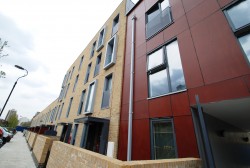With an increasing drive to ensure homes are as efficient as possible – particularly where heating, cooling and ventilation is concerned – it is important to carefully consider the various housebuilding options available. Andrew Carpenter, chief executive of the Structural Timber Association (STA) examines the suitability of SIPs in residential buildings.
Structural insulated panels (SIPs) utilise composite panel technology to provide load-bearing construction elements that combine structural and thermal properties into one solution. Typically, a SIP consists of two layers of Oriented Strand Board (OSB) sandwiching an insulation core, typically made up of either expanded polystyrene (EPS) of polyurethane (PU). The composite structure is much stronger than the sum of its parts with the insulation core stabilising the OSB and preventing deflection under loading.
Providing an efficient and indeed effective solution to reducing thermal losses, SIPs can help improve the energy conservation of a home. Thermal losses themselves are dictated by the hygrothermal performance – the transportation of heat, air and moisture through the building envelope.
This exchange of energy and mass is due to differentials between indoor and outdoor temperatures, pressures and humidity conditions. The greatest benefits are achieved through appropriate specification of materials combined with accurate design detailing at critical junctions.
While each of these areas is intrinsically linked, the hygrothermal performance can be split into three key sections – thermal resistance, thermal bridging and air tightness – for greater analytical assessment.
Thermal resistance
The thermal resistance of a material indicates its ability to transfer heat. In solids, this is directly proportional to the material’s thickness since heat is transferred via conduction. Therefore to improve the thermal resistance and reduce the U-value, an increase in thickness of building elements is required.
Since the thermal resistance of a building element is only one part of its performance requirement, increasing the thickness of the insulation levels without combining them into an integrated approach to the overall performance would provide uneconomically thick elements.
SIPs offer the efficiency of structural and thermal performance within one product. U-values as low as 0.11 W/m2K can be achieved through the use of SIPs while also limiting the increase in building dimensions (wall thickness). Thermal resistance gains can be achieved when assessing the surround build-up of the building element such as the cavity in a cavity wall. Providing a low-emissivity surface, such as aluminium foil, on the face of the SIP reduces the radiation transfer across the cavity, so that the airspace has a higher thermal resistance and therefore an associated reduction in U-value.
Thermal bridging
The construction format of SIPs means there are less timber members that fill the space between the outer and inner layer of a SIP wall profile to create what are called thermal bridges. Any interference of the insulation will cause a thermal bridge. The thermal calculations undertaken to determine the heat loss through a building’s fabric must include recognition of the thermal bridging factors. Consequently the building designer can benefit from the SIPs low thermal bridging factors.
Airtightness
The flow of air through a building is either controlled, e.g. through ventilation, or uncontrolled, e.g. through air leakage. Air leakage is created by gaps and cracks in the fabric of the building and leads to unnecessary heat loss, discomfort, interstitial condensation, increased sound transmission, degradation of the building envelope and increased energy costs.
Air leakage (or air permeability) is the rate of leakage in cubic metres of air per hour per square metre of envelope area at a reference pressure difference of 50 Pascals (Pa). SIP systems are capable of achieving excellent air tightness figures without the need for additional measures that would be required for most other building methods. The use of two layers of OSB and a central insulation core within a SIP provides a multi-layered air barrier combining low permeability materials. Large format panels and manufacturing tolerances limits the air leakage at connections and junctions. This can assist in providing an airtight construction significantly below 3m3/hour/m2 at 50 Pa.
In general, due to the large number of joints and junctions created by the majority of construction techniques, combined with the inherent permeability and porosity of the materials involved means that creating an efficient air barrier can be difficult. This often means that the effectiveness of the air barrier is based on the quality of site workmanship – however, the SIP system reduces this reliance on onsite workmanship through its detailing. Offsite manufacturing tolerances allow it to achieve excellent airtightness values, which are more difficult to achieve with most other building methods.
SIP systems provide a balanced approach to the hygrothermal performance that maximises gains in all areas without compromising others. The flexibility of the system permits a wide and varied building type and style to be built with very little restriction on size, shape and form.









